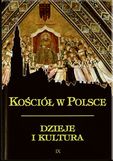STRUKTURA ADMINISTRACYJNA KOŚCIOŁA W POLSCE PRZED BULLĄ TOTUS TUUS POLONIAE POPULUS
The Administrative Structure of the Church in Poland before the Bull Totus Tuus Poloniae Populus
Author(s): Stanisław WilkSubject(s): History
Published by: Katolicki Uniwersytet Lubelski Jana Pawła II - Wydział Teologii
Keywords: Church organization; structure; Poland; "Totus Tuus Poloniae Populus"; papal bull
Summary/Abstract: Formed under the provisions of the Concordat of 1925 and the circumscription Vixdum Poloniae unitas Bull, the administrative structure of the Catholic Church in Poland survived until the Second World War. The political decisions made at Yalta and Potsdam caused a significant shift in Poland’s eastern and north-western borders, which created the need for changes in the organization and management of the Church, not only in these territories. Moreover, this need was due to the painful legacy of the Second World War, and – due to the exceptional situation – temporary solutions. Hence, the initiative to resolve pressing problems in this respect was made by Poland’s Primate Cardinal August Hlond, who in consultation with the Secretariat of State of the Holy See and by extraordinary power of attorney, after consultation with the Polish bishops, ‚tidied up’ ecclesiastical affairs in the country. After all, the most important project was the organization of the so-called administration of the reclaimed lands, to which displaced Poles arrived from central and south-eastern Poland, and where – as a result of unresolved jurisdiction dependencies – this lead to arbitrariness and abuses by the authorities of the communist state. In such a situation, Cardinal. A. Hlond established new administrative units in Opole, Wroclaw, Gorzow Wielkopolski and established administrators for them as well as for the Dioceses of Gdansk, Chelm and Warmia. In the eastern lands, where Poland only had small fragments of the Archdiocese of Lviv, Vilnius and the diocese of Pinsk, the organization of new centers in Lubaczow, Bialystok and Drohiczyn was undertaken by the existing ordinaries, and after their death, by successive capitular vicars and apostolic administrators. Further normalization of church organization took place on Polish territory under the authority of the Episcoporum Poloniae coetus Bull in 1972, the visit of Pope John Paul II in 1991 and the Totus Tuus Poloniae Populus Bull in 1992. At the same time, the Military Ordinariate and the regular structure of the Greek Catholic Church and the Armenian Church in Poland were restored.
Journal: Kościół w Polsce. Dzieje i kultura
- Issue Year: 2013
- Issue No: 12
- Page Range: 129-144
- Page Count: 16
- Language: Polish

